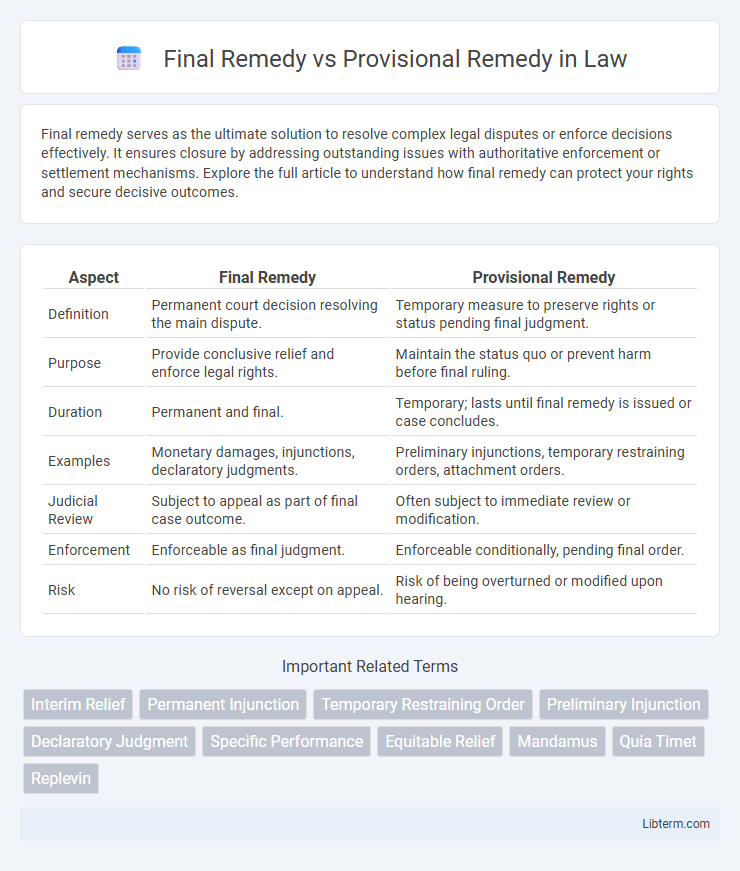Final remedy serves as the ultimate solution to resolve complex legal disputes or enforce decisions effectively. It ensures closure by addressing outstanding issues with authoritative enforcement or settlement mechanisms. Explore the full article to understand how final remedy can protect your rights and secure decisive outcomes.
Table of Comparison
| Aspect | Final Remedy | Provisional Remedy |
|---|---|---|
| Definition | Permanent court decision resolving the main dispute. | Temporary measure to preserve rights or status pending final judgment. |
| Purpose | Provide conclusive relief and enforce legal rights. | Maintain the status quo or prevent harm before final ruling. |
| Duration | Permanent and final. | Temporary; lasts until final remedy is issued or case concludes. |
| Examples | Monetary damages, injunctions, declaratory judgments. | Preliminary injunctions, temporary restraining orders, attachment orders. |
| Judicial Review | Subject to appeal as part of final case outcome. | Often subject to immediate review or modification. |
| Enforcement | Enforceable as final judgment. | Enforceable conditionally, pending final order. |
| Risk | No risk of reversal except on appeal. | Risk of being overturned or modified upon hearing. |
Introduction to Legal Remedies
Legal remedies are categorized into final remedies and provisional remedies, each serving distinct purposes within litigation. Final remedies, such as damages or specific performance, provide conclusive resolution and enforce the plaintiff's rights after adjudication. Provisional remedies, including injunctions or attachment, offer temporary relief to preserve the status quo or assets pending the court's final decision.
Definition of Final Remedy
A final remedy refers to a conclusive legal decision that resolves the core issues of a case, providing permanent relief or enforcement of rights. It concludes litigation by delivering a definitive judgment that determines the parties' obligations and rights regarding the dispute. Unlike provisional remedies, final remedies are binding and enforceable as the ultimate resolution in legal proceedings.
Definition of Provisional Remedy
Provisional remedy refers to a temporary court order or measure designed to preserve the status quo, protect assets, or secure evidence pending the final resolution of a case. These remedies include injunctions, attachment, garnishment, and receivership, which prevent harm or loss before a final judgment is rendered. Unlike final remedies, which conclude litigation by providing permanent relief, provisional remedies are interim solutions that ensure fairness and prevent irreparable damage during legal proceedings.
Key Differences Between Final and Provisional Remedies
Final remedies provide a conclusive resolution in a legal dispute, offering permanent relief such as damages or injunctions that fully address the plaintiff's claims. Provisional remedies, on the other hand, are temporary measures like preliminary injunctions or attachments designed to preserve the status quo or protect assets during litigation. The key difference lies in their timing and purpose: final remedies resolve the case on merits, while provisional remedies ensure effective enforcement of final judgments.
Legal Basis for Final Remedies
Final remedies are supported by established legal principles found in statutes, case law, and procedural rules, providing conclusiveness and enforceability after thorough judicial review. These remedies include judgments for damages, injunctions, or specific performance aimed at definitively resolving disputes. The legal basis for final remedies emphasizes the need for due process, the right to a fair trial, and adherence to substantive and procedural law to ensure justice is properly administered.
Legal Basis for Provisional Remedies
Provisional remedies are legally grounded in statutes or court rules designed to preserve the status quo and prevent irreparable harm before a final judgment is rendered. These remedies, such as injunctions, attachments, and garnishments, serve as temporary measures authorized to protect the plaintiff's interests during litigation. Unlike final remedies, which resolve the substantive rights of parties after full trial, provisional remedies rely on the urgent need to maintain fairness and prevent prejudice pending the outcome.
Examples of Final Remedies
Final remedies resolve disputes with definitive judgments, such as awarding monetary damages in breach of contract cases or issuing permanent injunctions to stop ongoing violations. Examples include compensatory damages in personal injury lawsuits, specific performance orders in real estate transactions, and declaratory judgments confirming the parties' rights. These remedies provide conclusive relief and enforce long-term compliance.
Examples of Provisional Remedies
Provisional remedies serve as temporary measures to preserve assets, maintain the status quo, or prevent harm before a final judgment is rendered in a legal dispute. Examples include preliminary injunctions, which restrain a party from certain actions; attachment, allowing seizure of property to secure a potential judgment; and garnishment, which permits withholding funds from a third party, such as an employer, to satisfy a claim. These remedies are crucial in safeguarding rights during litigation and differ from final remedies that provide conclusive relief.
Importance of Distinguishing Between Final and Provisional Remedies
Distinguishing between final and provisional remedies is crucial for ensuring proper legal strategy and protecting parties' rights during litigation. Final remedies, such as damage awards or declaratory judgments, conclusively resolve disputes, while provisional remedies like injunctions or attachments provide temporary relief to maintain the status quo. Correctly identifying these remedies prevents procedural errors, safeguards due process, and facilitates efficient case management in courts.
Conclusion: Final vs Provisional Remedies in Legal Practice
Final remedies provide conclusive resolution and enforceable judgments that fully address the rights and obligations between parties, often resulting in a definitive end to litigation. Provisional remedies, such as injunctions or attachments, serve as temporary measures preserving the status quo or preventing harm during ongoing proceedings but do not resolve the underlying dispute. In legal practice, understanding the strategic application of final versus provisional remedies is crucial for effectively protecting client interests and securing appropriate judicial relief.
Final Remedy Infographic

 libterm.com
libterm.com